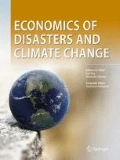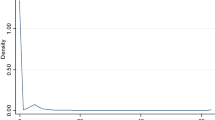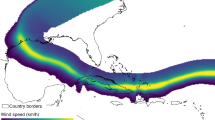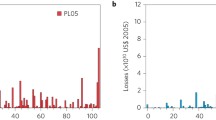Abstract
This paper is the first to examine the short term local economic impact of tropical cyclones by estimating the effects on monthly nightlight intensity. More specifically, for Guangdong Province in Southern China, we proxy monthly economic activity with remote sensing derived monthly night time light intensity and combine this with local measures of wind speed derived from a tropical cyclone wind field model. Our regression analysis reveals that there is only a significant (negative) impact in the month of the typhoon strike and nothing thereafter. Understanding that typhoons are inherently a short-term phenomenon has possible implications for studies using more aggregate data.


Similar content being viewed by others
Notes
Unlike our study they focus on a single event and only examine aggregate rather than local impacts.
For an example of the use of nightlights to examine the local economic impact of tropical cyclones using annual data see Elliott et al. (2015).
Unfortunately, given the normalization, the values can only be valued in relative terms.
We add 1 to all values so cells with zero values are not dropped.
For months when we use the average across different satellites, we also use the average of the number of cloud free days across satellites.
We also estimated each specification using 12 lags to investigate how the monthly coefficients changed over the period of one year (which is the usual data frequency used in studies of natural disasters). The main results did not change and are available from the authors upon request.
See, for instance, the discussion in Bier (2017).
References
Asia Disaster Reduction Centre (ADRC) (2013) Website accessed 15th August 2013. http://www.adrc.asia/nationinformation.php?NationCode=156&Lang=en&NationNum=22
Bertinelli L, Strobl E (2013) Quantifying the local economic growth impact of hurricane strikes: an analysis from outer space for the Caribbean. J Appl Meteorol Climatol 52:1688–1697
Bier M (2017) Understanding and mitigating the impacts of massive relocations due to disasters. Econ Disasters Clim Chang:179–202
Boose E, Serrano M, Foster D (2004) Landscape and regional impacts of hurricanes in Puerto Rico. Ecol Monogr 74:335–352
Chen X, Nordhaus WD (2011) Using luminosity data as a proxy for economic statistics. Proc Natl Acad Sci USA 108:8589–8594
Driscoll JC, Kraay AC (1998) Consistent covariance matrix estimation with spatially dependent panel data. Rev Econ Stat 80:549–560
du Pont W, Noy I (2016) Long-term consequences of natural disasters - a survey of the literature. mimeo
Elliott R, Puyang S, Strobl E (2015) The local impact of typhoons on economic activity in China: a view from outer space. J Urban Econ 88:50–66
Emanuel KF (2011) Global warming effects on US hurricane damage. Weather Clim Soc 3:261–268
Emanuel KF (2013) Downscaling CMIP5 climate models shows increased tropical cyclone activity over the 21st century. PNAS 110(30):12219–12224
Felbermayr G, Groschl J (2014) Naturally negative: the growth effects of natural disasters. J Dev Econ 111:92–106
Henderson V, Storeygard A, Weil DN (2011) A bright idea for measuring economic growth. Am Econ Rev 101(3):194–199
Holland G (1980) An analytic model of the wind and pressure profiles in hurricanes. Mon Weather Rev 106:1212–1218
Holland G (2008) A revised hurricane pressure-wind model. Mon Weather Rev:3432–3445
Knutson TR, McBride JL, Chan J, Emanuel K, Holland G, Landsea C, Held I, Kossin JP, Srivastava AK, Sugi M (2010) Tropical cyclones and climate change. Nat Geosci 3:157–163
Liu K-B, Shen C, Louie K-S (2001) A 1,000 year history of typhoon landfalls in Guangdong, southern China, reconstructed from Chinese historical documentary records. Ann Assoc Am Geogr 91(3):453–464
Mohan P, Strobl E (2017) The short-term economic impact of tropical cyclone pam: an analysis using VIIRS nightlight satellite imagery. Int J Remote Sens 38:5992–6006
Onuma H, Shin KJ, Managi S (2017) Reduction of future disaster damages by learning from disaster experiences. Nat Hazards 87:1435–1452
Paulsen B, Schroeder J (2005) An examination of tropical and Extratropical gust factors and the associated wind speed histograms. J Appl Meteorol 44:270–280
Tse CW, Wei J and Wang Y (2013), Social capital and disaster recovery: evidence from Sichuan earthquake in 2008, Centre for global development, working paper 344
Vickery PJ, Masters FJ, Powell MD, Wadhera D (2009) Hurricane hazard modeling: the past, present, and future. J Wind Eng Ind Aerodyn 97:392–405
Woolridge JM (2002) Econometric analysis of cross section and panel data. MIT Press, Cambridge, Mass
Xiao Y-F, Xiao Y-Q, Duan Z-D (2009) The typhoon wind hazard analysis in Hong Kong of China with the new formula for Holland B parameter and the CE wind field model. The Seventh Asia-Pacific Conference on Wind Engineering, Nov. 8-12, Taipei, Taiwan
Acknowledgements
Thanks for funding support from Nankai University, Business School and the Collaborative Innovation Centre in Nankai.
Author information
Authors and Affiliations
Corresponding author
Rights and permissions
About this article
Cite this article
Del Valle, A., Elliott, R.J.R., Strobl, E. et al. The Short-Term Economic Impact of Tropical Cyclones: Satellite Evidence from Guangdong Province. EconDisCliCha 2, 225–235 (2018). https://doi.org/10.1007/s41885-018-0028-3
Received:
Accepted:
Published:
Issue Date:
DOI: https://doi.org/10.1007/s41885-018-0028-3




